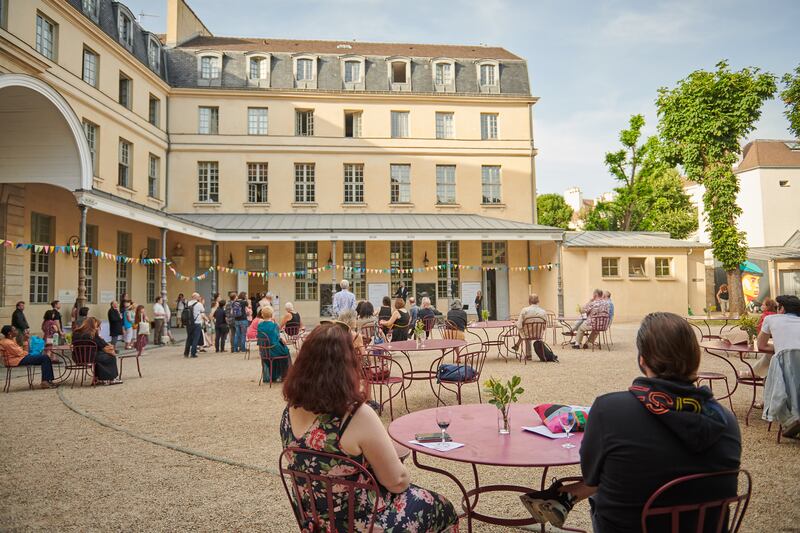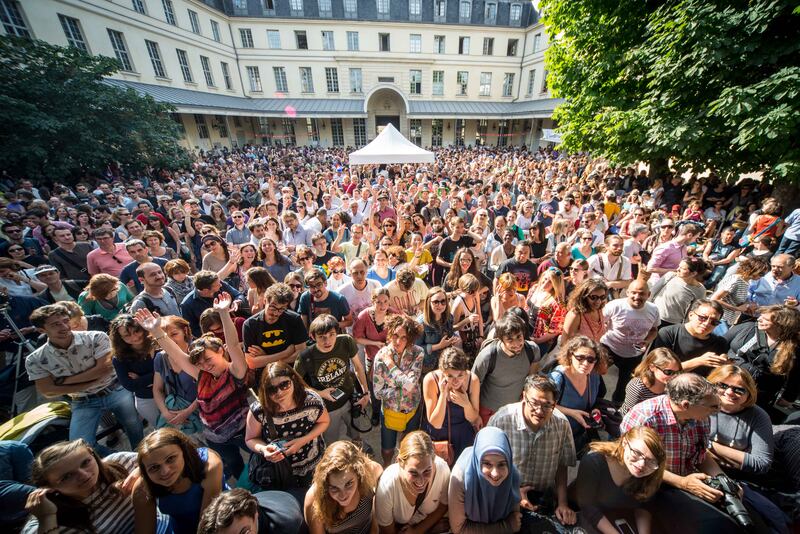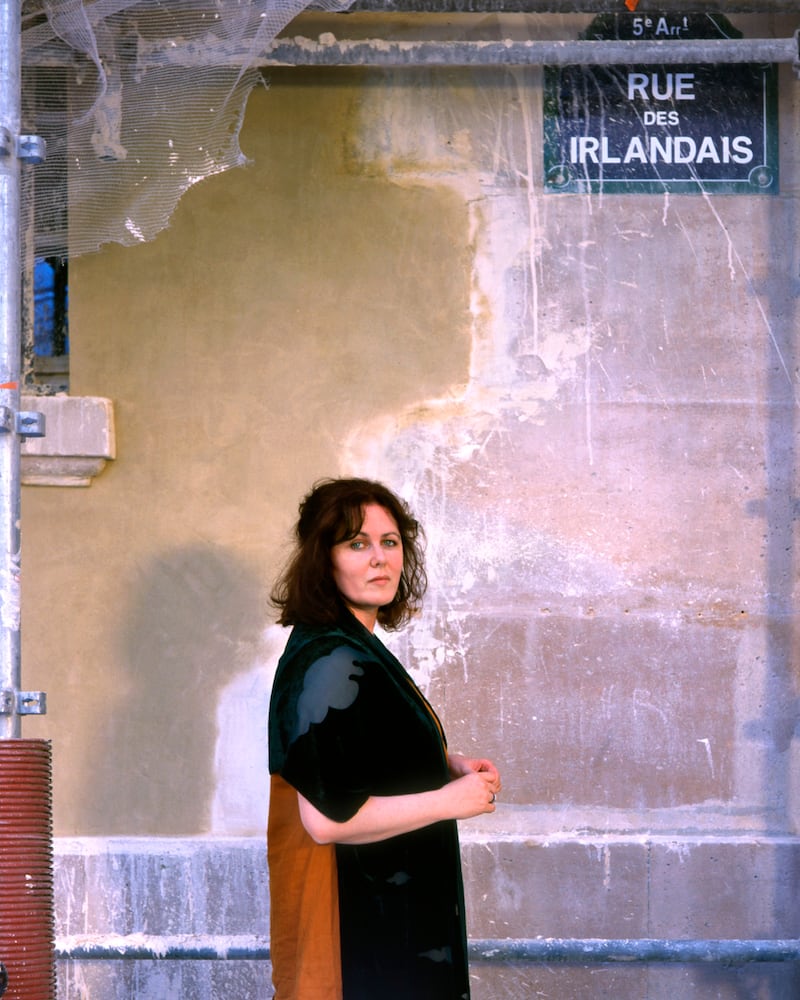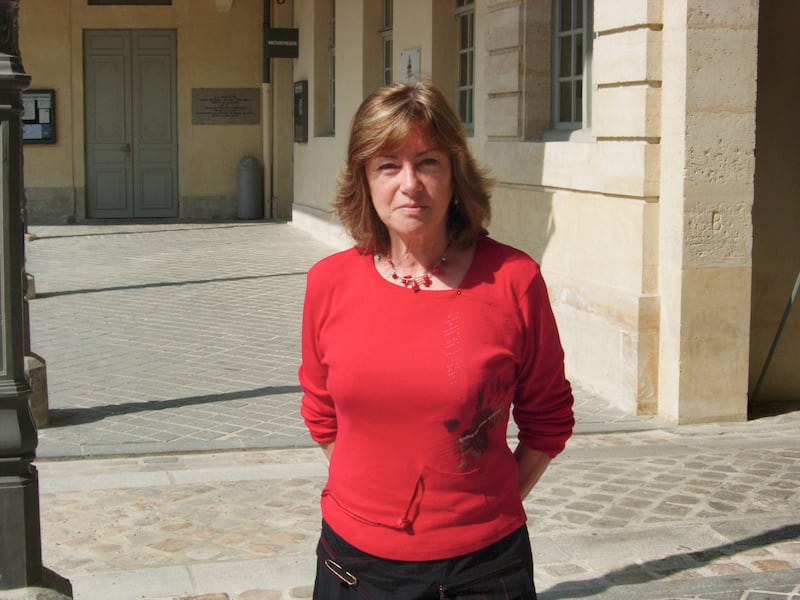Nora Hickey M’Sichili, the director of the Centre Culturel Irlandais (CCI) since 2013, has built on the achievements of her predecessors, Helen Carey and Sheila Pratschke.
The CCI, at 5 rue des Irlandais near the Pantheon in Paris, this autumn celebrates the 20th anniversary of its transformation from the centuries-old Irish College to Ireland’s leading arts centre abroad.
Hickey has increased the number of funding partnerships and cultural exchanges and extended the centre’s artists in residence programme. She has emphasised up-and-coming artists, musicians and writers, and has attracted larger, younger audiences.
Hickey says her most memorable event this year was the annual June 21st concert, which is part of the French Fête de la Musique. It is the CCI’s biggest event, routinely attracting between 5,000 and 9,000 people.
The Senegalese rapper Ngaaka Blindé was the star of this year’s concert. “He is a household name in Senegal,” Hickey says. “The courtyard was filled with Senegalese. We had Senegalese national television for the evening.”
The concert was a collaborative project by the Irish and Senegalese embassies in Paris, the French embassy in Dublin, the Cork Midsummer Festival and Culture Ireland, the government body which promotes Irish arts abroad.

Three of the five rappers are Irish citizens of African origin. “You might ask, ‘Why are you having Senegalese?’” Hickey laughs. She explains that the Irish Embassy in Paris has appointed diplomat Vincent Herlihy to strengthen ties with francophone west Africa, as part of Ireland’s commitment to La Francophonie. The same hip-hop artists will perform at the opening of the Irish Embassy in Dakar this year.
I told him we can talk about these things because Ireland has evolved. Ireland is confident now
Hickey calls a chance African link between herself and previous directors “the Zambian thread”. Her husband, the UCC-educated political analyst Alfred M’Sichili, is from Zambia. Her predecessor Sheila Pratschke lived in Zambia in the same town where Helen Carey, the first director of the CCI, was born.
By the time Hickey arrived at the CCI, Ireland’s most famous artists had already exhibited there. She has favoured thematic group exhibitions over monographs, including shows on climate change (2015) and surveillance (2018) which went on tour in Ireland.
[ Why I love living in... the Centre Culturel Irlandais, ParisOpens in new window ]
A group exhibition entitled A Nation Under the Influence, Ireland at 100, curated by Rosetta Beaugendre, the head of press and communications at the CCI, marked the centenary of the publication of James Joyce’s Ulysses.
An Irish official asked Beaugendre if the Magdalene laundries and the past total ban on abortion ought to be highlighted at the CCI. “I told him we can talk about these things because Ireland has evolved. Ireland is confident now,” Beaugendre says.
In an echo of the 1922 World Congress of the Irish Race in Paris, Hickey organised the CCI’s congress for Ireland this year, with lectures on climate change, Europe, migration and social justice.
The CCI was always an All-Ireland institution, but Northern participation has strengthened, in large part due to Brexit. The author and broadcaster Dearbhail McDonald, secretary of the Fondation Irlandaise which governs the CCI and chairperson of its strategy committee, is from Northern Ireland. So is Adrian Dunbar, the actor from the BBC series Line of Duty who serves as the CCI’s cultural ambassador.
“I was brought up in Fermanagh,” says Hickey. “My parents are from Kilkenny and Wicklow, so I always feel I am from the island. One of the first things I did was to approach the Arts Council of Northern Ireland and the British Council. They saw it as an opportunity, and they match funds. It’s a small amount of money, but it is symbolic.”
The property cannot be sold by the French or Irish government. It is iron tight
Culture Ireland and the Department of Foreign Affairs each contributed €240,000 to the CCI last year. This is far outweighed by the contribution of the French government, which in effect subsidises Irish culture by ploughing €1.1 million in annual income from rental properties belonging to the Fondation into the maintenance of the CCI.
Father John Lee from Waterford established the first Irish college in Paris 444 years ago. In 1769, Laurence Kelly, the prefect of the Collège des Lombards, purchased a town house and the grounds which comprise the present-day CCI for the purpose of housing both lay and clerical students. The court architect François-Joseph Belanger designed the U-shaped, four-storey building with a ground floor arcade around a large courtyard.


The Irish College was confiscated during the French Revolution. In 1805, Napoleon Bonaparte decreed that the Fondation Irlandaise, a French trust headed in aeternum by a French official, would administer the property. It served as an Irish seminary until the second World War.
In the 1980s and 90s, Monsignor Brendan Devlin, the single-minded head of the French department at Maynooth, gradually wrested the property from Polish priests who occupied it for 52 years, imposed an Irish presence on the board of the Fondation Irlandaise and, in league with retired Ulster Bank executives Billy Glynn and Frank O’Reilly, managed to interest the government in Dublin in its fate.
The government was initially reluctant to invest €14.5 million in renovations, because the deed is held by a French trust. “The property cannot be sold by the French or Irish government,” Glynn reassured Dublin. “It is iron tight.”
The courtyard was still filled with digging machines when Helen Carey arrived from the Galway Arts Centre 20 years ago. “The Celtic Tiger was booming. There was a lot of confidence around,” she recalls. “Our challenge was to make this bastion of Irish traditionalism into something that was vibrant, contemporary and dynamic.”

Carey established the CCI’s relationships with writers including John Banville, Anne Enright, Jennifer Johnston, Colum McCann and Nuala O’Faolain. She worked with the Paris-based visual artists Cleary Connolly and Beckett specialists Gare Saint Lazare Players. In 2006, she presented actor Olwen Fouéré's installation Here Lies, retracing Antonin Artaud’s journey through Ireland.
Carey organised a conference on the abolition of the death penalty, in conjunction with the Irish Centre for Human Rights, NUI Galway and with the participation of Robert Badinter, the French minister for justice who abolished the death penalty.
Pratschke, who led the CCI from 2007 until 2013, excelled at large literary events with celebrity guests. Her fondest memory is of the Feast of Friel, a five-day festival celebrating playwright Brian Friel’s 80th birthday in 2009. Friel’s plays were performed at the CCI, in his presence.
In 2012, Pratschke invited Sinéad Cusack, Marianne Faithfull, Bob Geldof and Charlotte Rampling to read poetry by Yeats in an homage to the Irish-born writer, theatre-producer and poetry lover Josephine Harte, who had died the previous year.
We might have a punk party here, but we wouldn’t have a punk party in front of the Virgin Mary statue
This correspondent will never forget the magical evening of June 13th, 2013, when Seamus Heaney read beneath the courtyard archway while close to 800 people listened spellbound.
A bird sang out from a tree in the courtyard. Heaney paused, then recited from memory his own translation of the ninth century Irish poem, The Blackbird of Belfast Lough. The Nobel laureate passed away two and a half months later.

In the early years of the CCI, there was tension over the role the Catholic Church should play in the centre. There was even a dispute over whether the chaplain should be allowed to park in the CCI lot. Some questioned why the most elegant apartment should be reserved for the chaplain.
The CCI has done daring things. A decade ago, Pratschke was surprised that no one objected to her programming a performance by transgender actors. The dancer and choreographer Fearghus Ó Conchúir, who is deputy chair of the Arts Council, danced naked in the refectory. Performance artist Amanda Coogan “showed a bit of cheek” at the front door of the CCI.
But, Hickey says, “There are certain things I would not programme for the chapel. A drum kit. Content. You would have to be respectful. It’s still a consecrated place. We might have a punk party here, but we wouldn’t have a punk party in front of the Virgin Mary statue.”
“In my time, the chaplains were inclined to be very strict about what could be presented in the chapel, which was a pity, because it has very good acoustics,” Pratschke recalls. “Now there seems to be a much looser attitude towards the use of the chapel for cultural events. I think that is progress.”

Up to 500 people attend mass on St Patrick’s Day, says Monsignor Hugh Connolly, who just completed five years as chaplain at the CCI. About 75 parishioners attend each Sunday. Though there is some overlap, the mass-goers are by and large not the people who attend the cultural events.
Mgr Connolly performed baptisms, marriages, and visited Irishmen in French prisons. His happiest memory is of the “all is well again moment” of a first Communion ceremony at the CCI after the Covid lockdown.
Hickey discussed the programming of non-religious cultural events to be held in the chapel with Mgr Connolly beforehand. If he received a complaint that “a profane word” had been used in a concert, he recalls: “We would always thrash it out with Nora…There was never anything that had to be elevated to the level of the Fondation.”
We are at the foot of the mountain, working with the Office of Public Works, the Department of Foreign Affairs and Culture Ireland. We have no idea how much money will be available
Carey questions the necessity of the chaplaincy, on the grounds that “Ireland has a lot of different faith groups now” and that “the strong presence of religion in this cultural centre looks eccentric” to the French.
By contrast, Hickey sees the cohabitation of Catholicism and contemporary culture in the CCI as emblematic of present-day Ireland. “Laicité exists in France, not in Ireland,” she says, referring to state-enforced secularism. “The Irish school system and hospitals are still largely run by the Church... Let’s face it; it was Irish priests who bought this building.”
In the early years of the CCI, “Nobody in Ireland knew the potential of a cultural centre in Paris. Now they do,” says Fiach Mac Conghail, the former director of the Abbey Theatre and ex-senator who was the original programme manager for the CCI and returned to its board in 2015.
“After 20 years, Nora and her team and the board know what is working and what is not,” says Mac Conghail. He, Hickey and McDonald are currently drawing up a master development plan.
“We are at the foot of the mountain, working with the Office of Public Works, the Department of Foreign Affairs and Culture Ireland. We have no idea how much money will be available,” Mac Conghail says.
A performance space for theatre and dance, a cellar jazz club, more artists’ studios and a cafe are on Hickey’s wish list. The team would like to double the number of artists in residence from five to 10, and reduce the number of student lodgers from 34 to 16.
More than 1,000 Irish students have found accommodation in the CCI over the past two decades. Four hundred artists in residence passed through in the same period. One hundred thousand people visit the centre annually, and 35,000 attend cultural events.
The CCI was to celebrate its 20th anniversary on Friday night with a film entitled Oblivion by the visual artist Aideen Barry, a concert by the musician Daithí, a laser sound and light show on the facade of the courtyard and an exhibition of rare books in the Old Library.
There is much to celebrate. Carey, Pratschke and Hickey, the CCI’s pioneering directors, fulfilled the mission assigned to them, to transform a historic building into a vibrant, buzzing arts centre which raised Ireland’s profile in France and on the Continent. They made the CCI a triumph for a distinctly Irish brand of soft diplomacy, and for Irish culture.





















